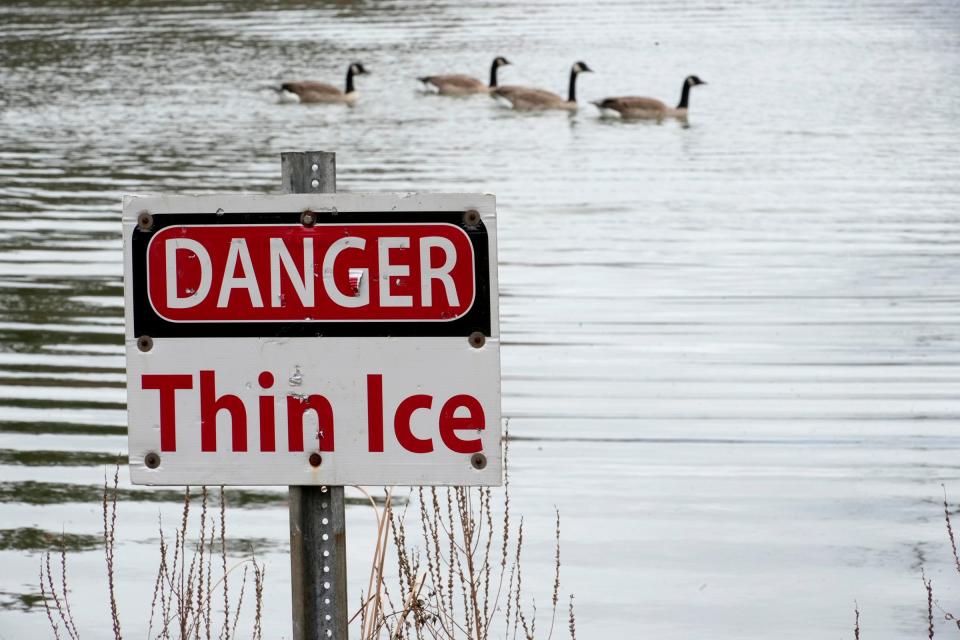Record warmth, Great Lakes ice cover hint at changing climate
December 2023 was the second-warmest on record, based on average monthly temperature, for Rochester, Buffalo and Watertown.
It hasn't been too surprising to anyone spending time outside in western New York. The temperatures have been mild and snow has been hard to come by.
Will it hold? This week, with major windstorms and cold forecast, it does not look like it. December's data might hold a trend lesson for the future, though.
The warmest December was 2015, which was the same year of the last strong El Niño event. Rochester is feeling the effects of El Niño this winter, which is a cyclical phenomenon and typically brings warmer winter conditions.
The Great Lakes had the lowest percentage of ice cover on Jan. 1 since data was first recorded in 1973, as reported in the Milwaukee Journal Sentinel.
There was no ice cover on Lake Erie and Lake Ontario as of Jan. 4; ice cover on both lakes typically peaks in mid-February. Lake Ontario typically sees less than 20% coverage, based on National Weather Service data.
Any time temperatures are at or near record highs, it can raise concerns about the connection to climate crisis. That was certainly the case for the evening of Dec. 28, which caught the attention of Climate Central, a nonprofit group of scientists and communicators. The evening low of 42 degrees was 20 degrees above normal and scored highly on the organization’s Climate Shift Index.

Climate change polls show Americans more worried about impacts
The impacts of climate crisis — and public perception of its effects — have been shifting over the years.
In December, the Yale Program on Climate Change Communication released the latest results in its Six Americas Survey, which looks at which category six Americans fall into: alarmed, concerned, cautious, disengaged, doubtful and dismissive.
The four-part questionnaire sorts respondents into six different categories based on their response.
Last fall, 28% of respondents were alarmed, with another 29% concerned — the two categories most concerned about, and motivated by, global warming. Respondents in those categories also have the highest belief in global warming.
The dismissive and doubtful categories, those least concerned or motivated about global warming, were both at 11%.
In the past decade, the alarmed category has grown the most. Only 15% of respondents were alarmed in 2013; the percentage more than doubled 10 years later. It was the same share of respondents as the doubtful category in 2013, which instead declined by four percentage points.
A USA TODAY/Ipsos poll released in September found a more pronounced divide on the topic of climate change, with 69% of respondents identifying as very concerned or somewhat concerned.
The same poll found most respondents were significantly more (23%) or somewhat more (30%) concerned about climate change now than in the past. A plurality of respondents (36%) said their views have not evolved, however.
A Pew Research Center survey, released in October, found 43% of Americans believe climate change is already causing a great deal, or quite a bit, of harm in the U.S. Only 28% of respondents believe it's causing a little harm or none at all.
While polls can’t answer questions about what the impact of climate change will be, they do offer an insight into the temperature of the country on the topic, and signal how ready the U.S. might be to take significant action to mitigate the warming planet.
If you’re one of the Americans concerned about climate change, consider signing up for USA Today’s Climate Point newsletter, written by Janet Wilson with the Palm Springs Desert Sun.
More: 2024's biggest astronomical events: Every eclipse, meteor shower and full moon all year
More: Rochester winters call to D&C's new weather, climate and lake issues reporter, Steve Howe
— Steve Howe covers weather, climate and lake issues for the Democrat and Chronicle and as a native upstate New Yorker thinks fall is the best season. Have any insight into changing winter weather? Share with him at showe@gannett.com.
This article originally appeared on Rochester Democrat and Chronicle: Second Warmest December in Rochester NY a sign of warming planet

